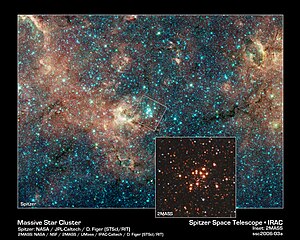RSGC1-F02
Appearance
| Observation data Epoch J2000 Equinox J2000 | |
|---|---|
| Constellation | Scutum |
| Right ascension | 18h 37m 55.28s[1] |
| Declination | −6° 52′ 48.4″[1] |
| Characteristics | |
| Apparent magnitude (J) | 9.904[1] |
| Apparent magnitude (H) | 6.695[1] |
| Details | |
| Radius | 1,128[2] R☉ |
| Luminosity | 215,000[2] - 363,000[1][3][4] L☉ |
| Temperature | 3,700[2] K |
| Other designations | |
RSGC1-F02 | |
| Database references | |
| SIMBAD | data |
RSGC1-F02 is a red supergiant located in the RSGC1 open cluster in the constellation of Scutum. Its radius was calculated to be between 1,499[1] and 1,549[3] times that of the Sun (the radius is calculated applying the Stefan-Bolzmann law), making it one of the largest stars discovered so far. This corresponds to a volume 3.37 and 3.72 billion times bigger than the Sun. If placed at the center of the Solar System, its photosphere would engulf the orbit of Jupiter.
See also
References
- ^ a b c d e f Davies, Ben; Figer, Don F.; Law, Casey J.; Kudritzki, Rolf-Peter; Najarro, Francisco; Herrero, Artemio; MacKenty, John W. (2008). "The cool supergiant population of the massive young star cluster RSGC1". The Astrophysical Journal. 676 (2): 1016–1028. arXiv:0711.4757. Bibcode:2008ApJ...676.1016D. doi:10.1086/527350. ISSN 0004-637X. S2CID 15639297.
- ^ a b c Humphreys, Roberta M.; Helmel, Greta; Jones, Terry J.; Gordon, Michael S. (August 2020). "Exploring the Mass Loss Histories of the Red Supergiants". The Astronomical Journal: arXiv:2008.01108. arXiv:2008.01108.
- ^ a b Fok, Thomas K. T.; Nakashima, Jun-ichi; Yung, Bosco H. K.; Hsia, Chih-Hao; Deguchi, Shuji (2012-11-20). "Maser Observations of Westerlund 1 and Comprehensive Considerations on Maser Properties of Red Supergiants Associated with Massive Clusters". The Astrophysical Journal. 760 (1): 65. arXiv:1209.6427. Bibcode:2012ApJ...760...65F. doi:10.1088/0004-637X/760/1/65. ISSN 0004-637X. S2CID 53393926.
- ^ Emma Bensor (2020). "A new mass-loss rate prescription for red supergiants". Monthly Notices of the Royal Astronomical Society. 492 (4): 5994–6006. arXiv:2001.07222. Bibcode:2020MNRAS.492.5994B. doi:10.1093/mnras/staa255.
{{cite journal}}: CS1 maint: unflagged free DOI (link)

